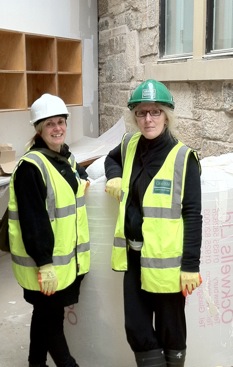
Vote for Maryhill in the National Lottery Awards!
We’re delighted to announce that Maryhill Burgh Halls has been shortlisted in this year’s National Lottery Awards in the category of Best Heritage Project.
Click here to vote for us in the Heritage category!
Now we need your help! To get through to the next round, please show your support and consider voting for us – the three projects in each category with the most votes by July 22nd will go through to the final – and be featured on a BBC TV program about the awards.
You can vote for free via the website at
www.lotterygoodcauses.org.uk/awards
or by ringing
0844 836 9715
(calls cost just 5p from a BT Landline).
If you've enjoyed visiting Halls, have been to an event here, or just like what we've done to bring the buildings back to life, this is a great way to show your support - if you choose to vote for us,
Thank You!
If not, then please look at the other fantastic projects involved, and vote for one of them instead...
Hunter Reid, Project Co-ordinator at Maryhill Burgh Halls Trust, said:
“Funding from the National Lottery was crucial in allowing us to bring Maryhill Burgh Halls back to life and we’re delighted that the project has now been selected as a semi-finalist in The National Lottery Awards. The project not only allowed for the restoration and development of these magnificent buildings, but it is also bringing a much loved hub for community activity and celebration back to life!
“We are delighted with the feedback so far from both the local community and also visitors from further afield who are now able to experience the historically rich area of Maryhill. We hope that they will continue to support us and, of course, vote us Best Heritage Project in The National Lottery Awards!”
The Burgh Halls Project
The project has brought three derelict, “at risk”, listed buildings in the heart of one of the most deprived areas in Scotland back to life - giving a new focus for the local community. It mixed traditional building methods with high-quality new build, to create vibrant, in-demand facilities for the area, including a public hall/events space, meeting rooms, a cafe, a nursery, community and commercial recording studios, heritage displays, plus over 10,000 sq ft of high spec office space. Complementing the buildings are a series of historically and socially unique stained glass windows from 1878, depicting the trades and working people of the local area, now restored and back on display for the first time in nearly half a century, alongside new artworks inspired by local people.
Find out more about the project at
Muppets in Maryhill!
It's time to play the music, it's time to re-light the lights - as film returns to Maryhill Burgh Halls for the first time in decades!
THE GROSVENOR CINEMA, IN PARTNERSHIP WITH THE WEST END FESTIVAL, PRESENTS AN AUTHENTIC 35MM CINEMA EXPERIENCE AT MARYHILL BURGH HALLS ON 23RD JUNE AT 11AM.
The popular Grosvenor Cinema of Ashton Lane in Glasgow’s West End, as a part of The West End Festival, are proud to present a community screening of the brilliant family movie ‘The Muppets’ at Maryhill Burgh Halls on Saturday 23rd June at 11am.
Tickets are only £1.00 but be there as you will see a demonstration of authentic 35m projected film. Have you ever wondered just what goes on behind that light at the back of the cinema in the projection box? On the 23rd June we will show you, using a genuine projector taken out of a Glasgow cinema that will not only be on display but will be used to show you ‘The Muppets’. Prior to the film we will also give a short talk of how 35m developed and how we have now entered the digital age.
Not only will this be lots of fun it will also be a great brief history lesson for all the family, not to mention a chance to experience a rapidly disappearing way of showing films on screen.
Ken Creelman, Cinema Development Manager for the Grosvenor Cinema said; “We are delighted to work with both The West End Festival and Maryhill Burgh Halls in bringing authentic 35m film to a unique setting for families in the area. As Glasgow’s oldest operating cinema, The Grosvenor wants to give something back to the community and showing films is still the most enjoyable family outing. We hope to do more of these screenings around Glasgow in the future but where better to start than this magnificent historic building, and as part of the West End Festival”.
Melanie Farrow; Manager of Maryhill Burgh Halls said; “Being able to bring the Muppets to the newly re-opened Maryhill Burgh Halls is fantastic – the Halls was showing films on Saturdays for children as long ago as 1910, so it’s a very appropriate location to learn about the heritage of film! We hold many different types of events here and I am sure cinema will be a welcome addition. We hope people both in Maryhill and across north Glasgow will enjoy this screening, which will hopefully lead to many more such shows”.
Ann McKechin, MP for Glasgow North said; “I am delighted that Maryhill Burgh Halls is partnering with the Grosvenor Cinema in this way. Both venues are huge assets to the local community and it makes perfect sense for local families to have use of the Grosvenor facilities right on their doorstep in the Burgh Halls. I look forward to many more screenings!”
Tickets for the screening of ‘The Muppets’ at Maryhill Burgh Halls can be purchased from The Grosvenor Cinema; www.grosvenorcafe.co.uk 0845 166 6028, or on the door at Maryhill Burgh Halls from 10am on the 23rd of June.
Re-Opening Week Events in Late April

To celebrate the re-opening and completed restoration of the 134-year old Maryhill Burgh Halls, we are delighted to announce a series of free public events in late April - please come along to see the building, and what’s on offer!
Lunchtime Concert Performance
________________________________________
Open Rehearsal with Glasgow Orchestral Society
________________________________________
Tea Dance with Willie & Anne
________________________________________
Building Re-Opening Day - FREE
Maryhill’s New Stained Glass Windows of Today revealed at last !
Press Release:
Set of ten includes the world’s first ever interactive stained glass window!
Stained glass is an ancient art form that stretches back hundreds of years. Now, here at Maryhill Burgh Halls, we’re ready to reveal the world’s first ever interactive stained glass window.
Scan the 2D barcode in the window with your smartphone, and you’ll be automatically taken to a webpage explaining the designs and giving information about the glass.
While the new glass is as modern as can be, stained glass in Maryhill has a long history: in 1878, the then Burgh commissioned twenty stained glass windows to showcase the trades and industries of Maryhill. They were designed by the artist Stephen Adam, and have become known as the crown jewels of Maryhill.
In 2010, Maryhill Burgh Halls Trust decided to commission ten new stained glass windows, to celebrate the completion of the multi-million pound restoration of the Halls.
Around 250 local people - ranging in age from 6 to well over 65! - got involved in the process, learning about the techniques involved in stained glass making, creating their own stained glass, and crucially, having their say as to the kinds of things the new windows should depict.
Featured in the original 1878 windows were boatbuilders, glassblowers, iron moulders and a canal boatman - what things would the people of modern Maryhill like to see captured in glass for the 21st century?
Glass artist Alec Galloway, working with community specialist Margo Winning, has distilled the hundreds of comments and suggestions down into a variety of themes depicted in ten new windows.
Alec says: “I have to thank everyone at Maryhill for giving me their time and having faith that I could deliver the ideas that were presented - the key to the project has been the close community involvement and the fact that so much has come directly from the people and imagery of Maryhill itself.
I wanted to create something different from the original 1878 Adam windows, but that would sit along side them and not become overshadowed. They are defined by the screenprinting technique, something that I'd only really done on a few pieces before - this then marks them out as being pretty unique as an architectural glass scheme anywhere in the UK.
I really do look forward to seeing them permanently on display in the Burgh Halls!”
Margo commented: “It quickly emerged that the multiple layers of communities that make up Maryhill were very keen to express their thoughts and ideas in a range of ways; including writing, drawings, glass making and in endless interesting discussion and chat. It provided an enormously valuable introduction and connection to the area and community, letting me learn more about the place and people in a few weeks than I otherwise could have in years. It has been a delightful project to be involved in.”
Gordon Barr, Heritage Development Officer for the Trust, said:
“We’re really excited to finally see the results of all the hours of workshops and talks, and the effort put into this, not just from Alec and Margo, but from the literally hundreds of local people who got involved in various ways to have their say, try out some of the techniques involved in making stained glass, and in some cases, have their images actually featured in the glass itself.
The original Adam windows - which thanks to Glasgow Museums will be coming back to be displayed in the building very soon - have lasted over 130 years. Hopefully in another 130 years - around the year 2145 - the descendants of some of the school pupils featured in these new windows will be coming to the Burgh Halls to see just what their great-great grandfather looked like when he was in Primary 7 !”
Key funding for the Windows of Today project came from the Heritage Lottery Fund. Colin McLean, Head of the Heritage Lottery Fund in Scotland, said:
“In 1878 the most magnificent stained glass windows were unveiled to celebrate the opening of the Burgh Halls. Over a hundred years on, the art of stained glass has inspired the community to come together again to celebrate their rich heritage. With their roots in the past, these new windows are a symbol of the future and the people of Maryhill should be extremely proud of what they have achieved.”
The ten new windows have the following themes:
Education - featuring Primary 7 children from a local school
Culture - featuring Maryhill-born Turner prize winners Douglas Gordon & Susan Philipsz
Social Heritage - featuring Jaconelli’s cafe
Heavy Trades - featuring the Maryhill canal and locks
Workers - featuring the Bryant & May match factory
Space Age - featuring a local company that makes satellites
Youth - featuring a local youth club
Sport and Leisure - featuring the Maryhill Harriers running club, and 2 local football teams
Regeneration - featuring the Burgh Halls itself, and the silver key that opened it in 1878
Diversity - featuring some of the many different cultures now making up Maryhill
Connecting all the windows are excerpts from archive maps of the area, and lines from the song ‘Voices’, written by Kevin McDermott, about growing up in the Maryhill area.
Notes to Journalists
Using money raised through the National Lottery, the Heritage Lottery Fund (HLF) sustains and transforms a wide range of heritage for present and future generations to take part in, learn from and enjoy. From museums, parks and historic places to archaeology, natural environment and cultural traditions, we invest in every part of our diverse heritage. To date it has invested over £500million in Scotland’s heritage.
Further information
Please contact Shiona Mackay on 01786 870638/07779 142890 (shionamackay1@btinternet.com) or Jon Williams on 0207 591 6035 (jonw@hlf.org.uk). Website www.hlf.org.uk
This news release is issued by Maryhill Burgh Halls Trust www.maryhillburghhalls.org.uk
Further information is available from Gordon Barr, Heritage Development Officer, 0794 081 5202 at any time or email: press@mbht.org.uk
About the Regeneration Project
The 133 year old building has undergone a £9.6 million restoration project, which has breathed new life into the iconic Halls, saved them for the community, created a thriving centre for business, and made the place once again the focus and beating heart of Maryhill.
Maryhill Burgh Halls Trust raised this remarkable sum to secure a bright future for the treasured Halls and in so doing recapture the splendor of one of the city's best loved buildings.
The restoration work began in November 2009 and is now complete, with the building due to open fully in the very near future.
In November 2010, the project was awarded a prize for best contribution to Urban Regeneration in Scotland through the use of European Structural Funds at the European Structural Funds Best Practice Awards.
Maryhill Burgh Halls were the seat of municipal government in the days before Maryhill was a part of Glasgow. Built in 1878 and designed by renowned architect Duncan McNaughtan, they have lain derelict for the past eight years and are listed on the Buildings at Risk register. Once open, the Halls will include a modern public hall, cafe, 11 offices, a commercial and a community recording studio, a nursery, meeting rooms and courtyard garden. Around 7 years of hard work has been put into developing proposals for the project.
The Board of the Trust, which comprises local people and representatives from partners Maryhill Housing Association, Cube Housing Association and Glasgow City Council, has worked tirelessly to deliver the restoration.
The contractor for the project Graham Construction has secured employment opportunities within the local community by creating three apprenticeships in joinery to work on the Halls restoration. Funding for the Maryhill Burgh Halls project has come from:
European Regional Development Funding £1.327m
Scottish Government City Growth Fund Phases 1 and 2 £1.26m
Heritage Lottery Fund £1.16m
Big Lottery - Growing Community Assets Fund £980,910
Glasgow City Council Better Glasgow Fund £1.02m
Glasgow City Council Vacant and Derelict Land Fund £675,000
Scottish Government Town Centre Regeneration Fund £1.8m
Historic Scotland £593,000
Scottish Government Wider Role Fund £764,000
The Robertson Trust £28,000
Everyone who is interested in following the development of the project through to completion can view progress and comment on the project on the Trust's Website at www.maryhillburghhalls.org.uk
Unlocking the past with Maryhill's silver key!
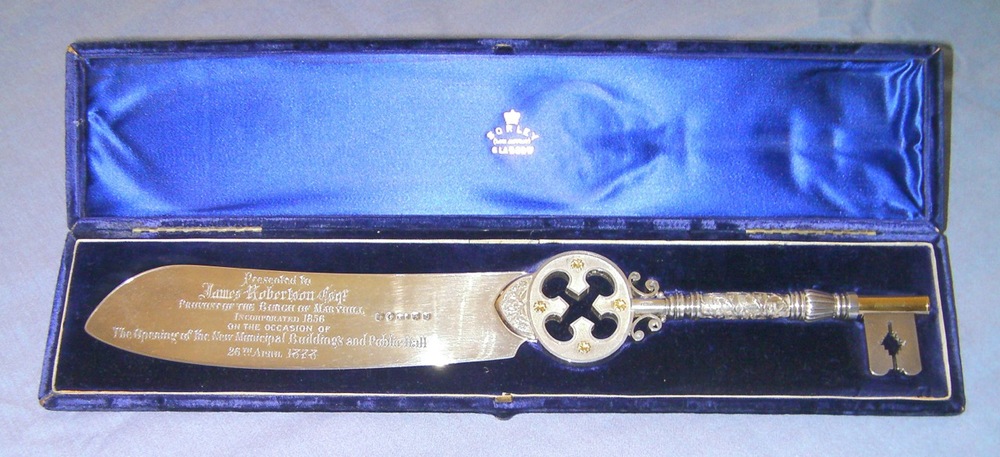
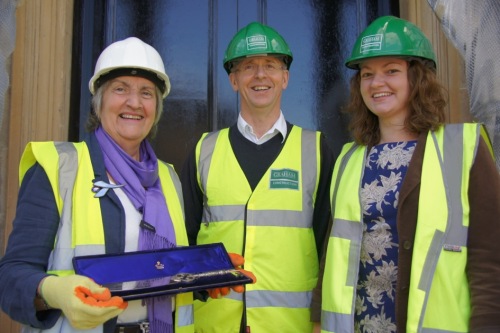
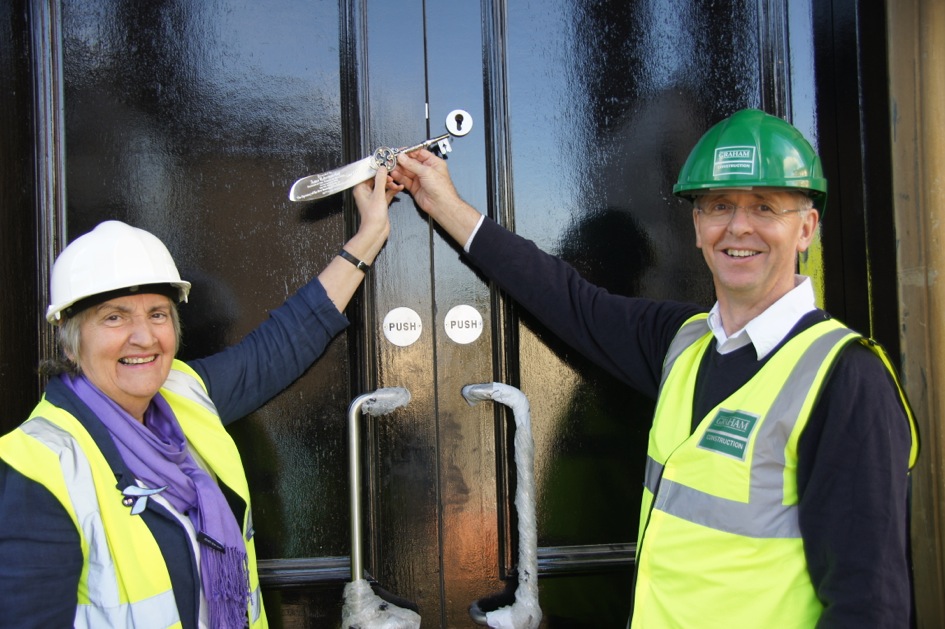
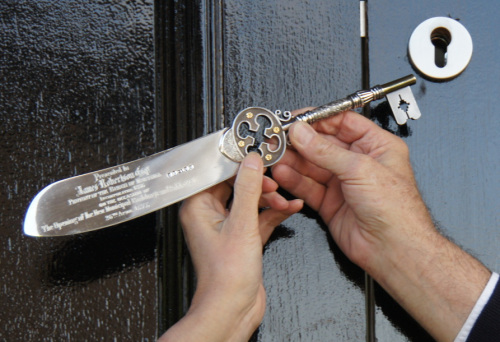
The 133 year old buildings, which contained 20 stained glass windows designed by Stephen Adam in 1878 depicting the trades of Maryhill, have undergone an over £9 million restoration project, which will breathe new life into the iconic Halls, save them for the community and create a thriving centre for local people and business use. The restoration work began in November 2009. Maryhill Burgh Halls Trust raised this remarkable sum to secure a bright future for the treasured Halls and in so doing recapture the splendour of one of the city's best loved buildings. In November 2010, the project was awarded a prize for best contribution to Urban Regeneration in Scotland through the use of European Structural Funds. Once restored, the Halls will include a modern public hall, cafe, 11 offices, a commercial and a community recording studio, a nursery, meeting rooms and garden courtyard. The contractor for the project, Graham Construction, has secured employment opportunities within the local community by creating three apprenticeships in joinery to work on the Halls restoration. The Funders for the project are: European Regional Development Funding , Scottish Government City Growth Fund Phases 1 and 2, Heritage Lottery Fund, Big Lottery - Growing Community Assets Fund, Glasgow City Council Better Glasgow Fund, Glasgow City Council Vacant and Derelict Land Fund, Scottish Government Town Centre Regeneration Fund, Historic Scotland, Scottish Government Wider Role Fund, The Robertson Trust.
Grassroots Organic to provide catering for Maryhill Burgh Halls
The refurbished Maryhill Burgh Halls are set to re-open towards the end of October 2011 – and when they do, the café and catering facilities will be provided by long established Glasgow company Grassroots Organic.
Irene Scott, Chair of Maryhill Burgh Halls Trust said “The Trust is delighted to announce that the well known Glasgow business, Grassroots Organic, will be both the operator for the Cafe within the buildings and the catering provider for functions in the Halls.”
Louise Duncan, Director of Grassroots Organic said "We are really looking forward to opening up in Maryhill in the fabulous spaces in the newly restored Halls. When we started our store and restaurant at St George’s Cross in Glasgow over 10 years ago, it was with the aim of promoting better nutrition and good health. That aim holds true today and will be the focus of our operation at Maryhill Burgh Halls. At Grassroots, we pride ourselves on the quality and tastiness of our food – both meat and vegetarian. Our catering for weddings and events will be tailored to customer requirements and budgets. We will also circulate a monthly newsletter with a focus on seasonal foods and we will hold classes and talks suitable for a variety of age groups focussing on health weeks and health issues."
Image - From left to right: Melanie Farrow, Halls Manager; Louise Duncan, Director, Grassroots Organic
The Halls will be an exciting new destination for both the local and wider community and will once again be the beating heart of Maryhill. If you would like to get involved as a volunteer, or to find out about our facilities for meetings, events, weddings and dinners, please get in touch – email us at info@mbht.org.uk or ring Halls Manager Melanie Farrow on 0845 860 1891 for more details or to make a booking.
Melanie Farrow, Halls Manager said: “The Trust is delighted that the buildings will soon be open for business and would like to invite everyone who is interested to come and see the buildings and make use of the facilities.”
The 133 year old buildings, which contained 20 stained glass windows designed by Stephen Adam in 1878 depicting the trades of Maryhill, have undergone an over £9 million restoration project, which will breathe new life into the iconic Halls, save them for the community and create a thriving centre for local people and business use. The restoration work began in November 2009. Maryhill Burgh Halls Trust raised this remarkable sum to secure a bright future for the treasured Halls and in so doing recapture the splendour of one of the city's best loved buildings. In November 2010, the project was awarded a prize for best contribution to Urban Regeneration in Scotland through the use of European Structural Funds.
Once restored, the Halls will include a modern public hall, cafe, 11 offices, a commercial and a community recording studio, a nursery, meeting rooms and garden courtyard. The contractor for the project, Graham Construction, has secured employment opportunities within the local community by creating three apprenticeships in joinery to work on the Halls restoration.
The Funders for the project are: European Regional Development Funding , Scottish Government City Growth Fund Phases 1 and 2, Heritage Lottery Fund, Big Lottery - Growing Community Assets Fund, Glasgow City Council Better Glasgow Fund, Glasgow City Council Vacant and Derelict Land Fund, Scottish Government Town Centre Regeneration Fund, Historic Scotland, Scottish Government Wider Role Fund, The Robertson Trust.
Burgh Halls regains its Manager!
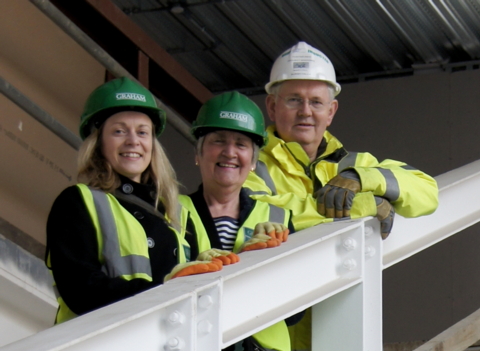
Maryhill Stained Glass: 130 year old mystery solved at last!
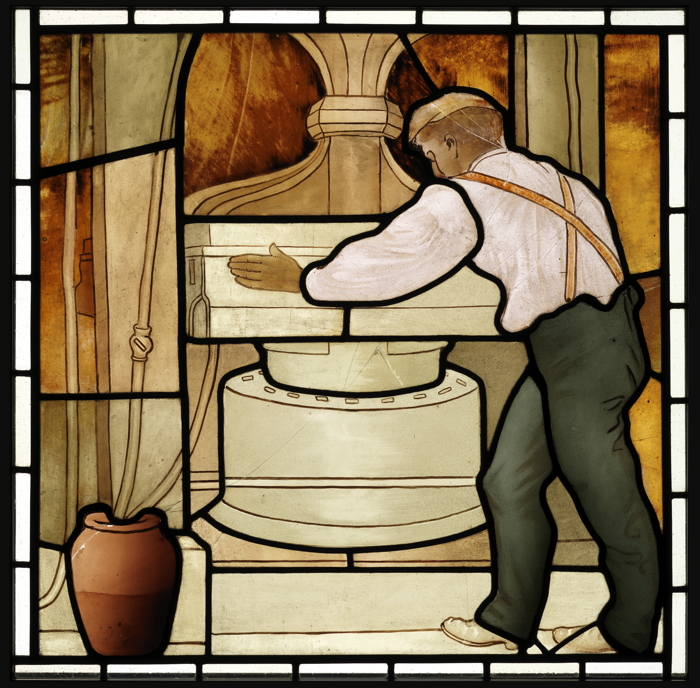
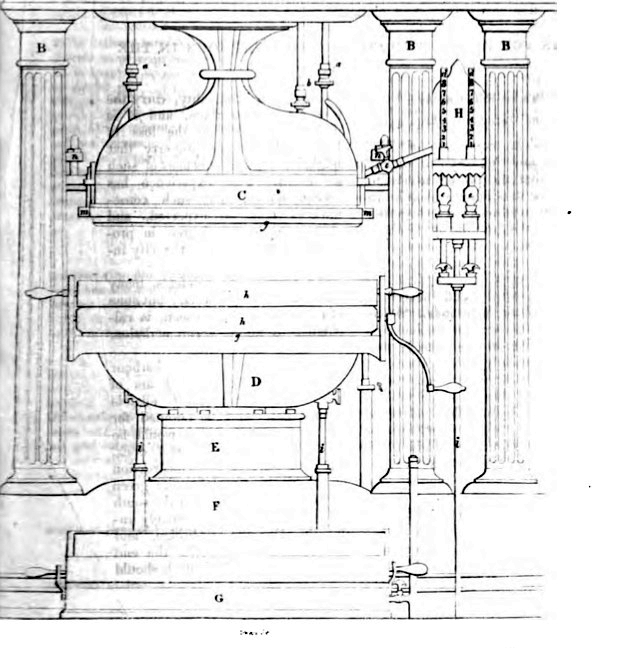
Towering Achievement: Maryhill Burgh Halls regains its crowning glory
For over a hundred years, the facade of Maryhill Burgh Halls was topped by an elegant, octagonal cupola tower, crowned by a wind vane - but it was removed in the early 1980s as it was becoming dangerous.
Now, as a major milestone in the ongoing, award-winning £9.2 million restoration project, a brand new hand-crafted replica of the original tower has been lifted up to the roof - over 60 feet above the street - by a giant crane.

The building contractor putting the building together is Graham Construction. The new cupola has been designed by JM Architects to be as close as possible a replica of the original, based on archive photos and drawings. Built by hand by specialist joinery contractors Hutton and Read, the cupola tower is an impressive 5 feet in diameter, 12 feet high, and is made from Douglas Fir, covered in hand-worked lead.
The wind vane is also hand made, designed and manufactured specially by P Johnston & Co. blacksmiths at Ratho Byres Forge.
Irene Scott, Chair of the Trust said:
“Now fixed back on the crest of the roof, the stunning cupola restores the exterior of this historic listed building back to how it looked when it first opened in 1878. It helps show the grand scale and ambition of the original, as well as helping to make clear how much progress has been made in the lead up to the Halls finally re-opening later this year.”
Hunter Reid, Project Co-ordinator and Company Secretary of the Trust added:
“The tower isn’t just decorative - it also forms a key part of the ventilation system of the refurbished building, which as much as possible uses natural ventilation to draw fresh air into the building. It’s great to see it back, and we’re delighted by the attention to detail and high-quality workmanship involved”.
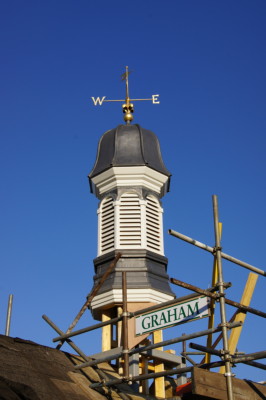
Notes to Journalists:
This news release is issued by Maryhill Burgh Halls Trust www.maryhillburghhalls.org.uk
Further information is available from Hunter Reid, Project Co-ordinator and Company Secretary on 07808 739627 or Dr Gordon Barr, Heritage Development Officer, 0794 081 5202 at any time
e mail: press@mbht.org.uk
About the Project
The 132 year old building is just over half way through a £9.2 million restoration project, which will breathe new life into the iconic Halls, save them for the community, create a thriving centre for business, and make the place once again the focus and beating heart of Maryhill.
Maryhill Burgh Halls Trust raised this remarkable sum to secure a bright future for the treasured Halls and in so doing recapture the splendor of one of the city's best loved buildings. The restoration work began in November 2009 and is scheduled for completion in the summer of 2011.
In November 2011, the project was awarded a prize as Best contribution to Urban Regeneration in Scotland through the use of European Structural Funds at the European Structural Funds Best Practice Awards.
Maryhill Burgh Halls were the seat of municipal government in the days before Maryhill was a part of Glasgow. Built in 1878 and designed by renowned architect Duncan McNaughtan, they have lain derelict for the past eight years and are listed on the Buildings at Risk register.
Once restored, the Halls will include a modern public hall, cafe, 11 offices, a commercial and a community recording studio, a nursery, meeting rooms and courtyard garden.
Around 6 years of hard work has been put into developing proposals for the project. The Board of the Trust, which comprises local people and representatives from partners Maryhill Housing Association, Cube Housing Association and Glasgow City Council, has worked tirelessly to deliver the restoration.
The outstanding architectural appeal and historic merit of the Halls is further enhanced by a unique series of stained glass panels depicting the trades and industries of Maryhill in the late 19th century, and which are currently in safe keeping with Glasgow Museums.
The restoration will also see a significant collection of the 20 stained glass windows, conserved and returned to the Burgh Halls. In addition, the Trust has recently commissioned 10 new “Windows of Today” which will depict life in Maryhill as it is now.
The contractor for the project Graham Construction has secured employment opportunities within the local community by creating three apprenticeships in joinery to work on the Halls restoration.
Funding of the project has come from the following sources:
European Regional Development Funding £1.279m
Scottish Government City Growth Fund Phases 1 and 2 £1.25m
Heritage Lottery Fund £990,000
Big Lottery - Growing Community Assets Fund £980,910
Glasgow City Council Better Glasgow Fund £1.02m
Glasgow City Council Vacant and Derelict Land Fund £650,000
Scottish Government Town Centre Regeneration Fund £1.8m
Historic Scotland £500,000
Scottish Government Wider Role Fund £750,000
The Robertson Trust £28,000
Everyone who is interested in following the development of the project through to completion can view progress and comment on the project on the Trust's Website at www.maryhillburghhalls.org.uk
EUROPEAN AWARD FOR MARYHILL BURGH HALLS !
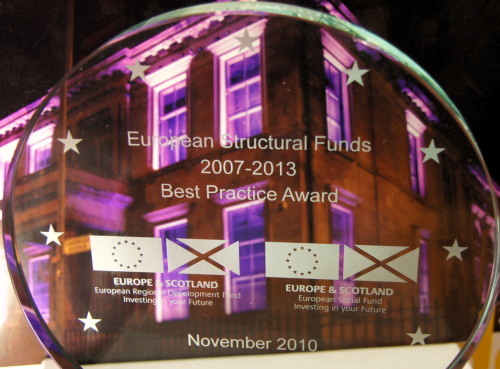
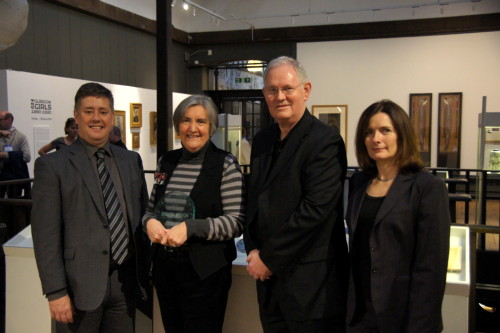
MSP Keith Brown, left, presents the award to Trust Chair Irene Scott, with Hunter Reid and Donna Brooks.
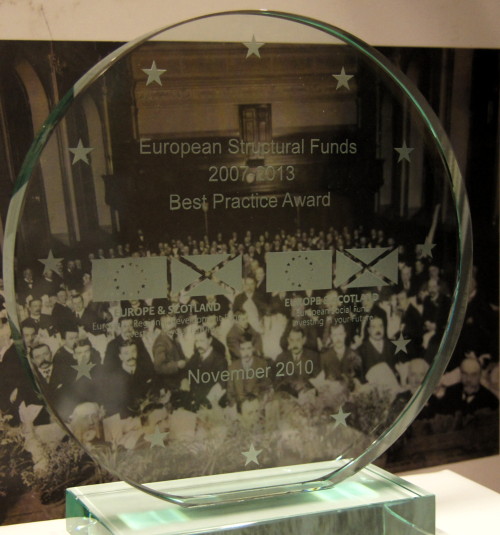
GETTING YOUR HANDS ON HISTORY!
Halls throw open the doors for exclusive hands-on heritage preview which proves a sell-out hit


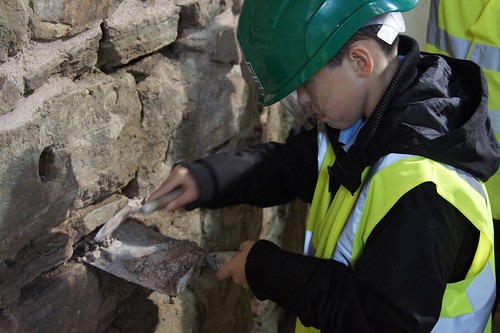
East Dunbartonshire Gen: Unveiled: East Dumbartonshire Based Designer Creates New Gates for Halls in Glasgow
Reproduced by kind permission of East Dumbartonshire Gen/Re-Gen newspapers
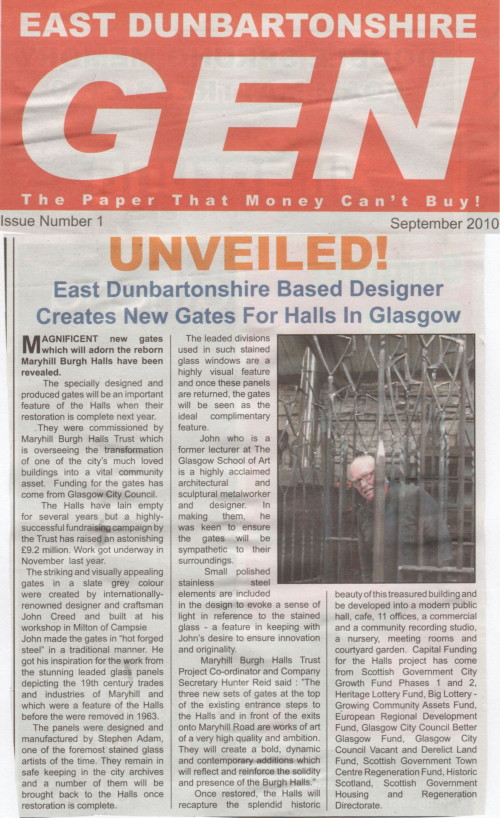
Stained Glass Tender Opportunity: Help design the 'Windows of Today'
The Trust has funding in place, and has just issued a Commissioning Brief for, a major new stained glass-based arts and interpretation project called the ‘Windows of Today’.
This will involve two main strands:
Firstly, a series workshops and hands-on opportunities for local people to learn about the history and practicalities of stained glass manufacture, while providing input into what they feel new stained glass should represent;
Secondly, the design and construction of a series of brand new stained glass windows representing the Maryhill of today, based on the feedback and input from the local community workshops.
We would like to invite you to consider tendering for the contract to provide the services described above. Further details can be found here, or on the Public Contracts Scotland website at
http://www.publiccontractsscotland.gov.uk
(with Tender ID no. JUL080233).
Along with some of the original Stephen Adam stained glass, which will be displayed in the Halls on loan from Glasgow Museums, the newly commissioned ‘Windows of Today’ will feature prominently in the ongoing marketing and promotion of the Burgh Halls; this will therefore be a high-profile, large scale commission.
If you are interested in getting involved, please get back to me as described in the attached document by 5pm on the 16th of August; or if you have any specific questions or queries please don’t hesitate to get in touch in the meantime.
info@mbht.org.uk Tel. 0141 948 1104
History in the making! Apprentices find work bringing Maryhill’s beloved Burgh Halls back to life
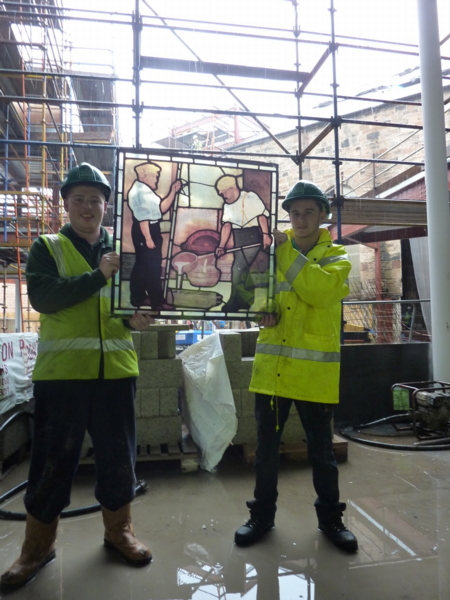
BIG PROGRESS AS THE HALLS TAKE SHAPE
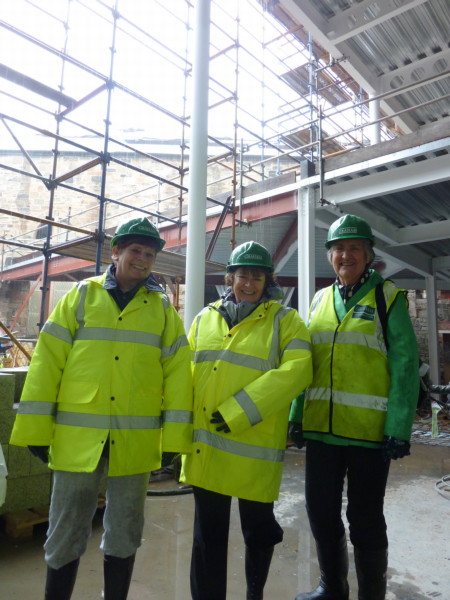
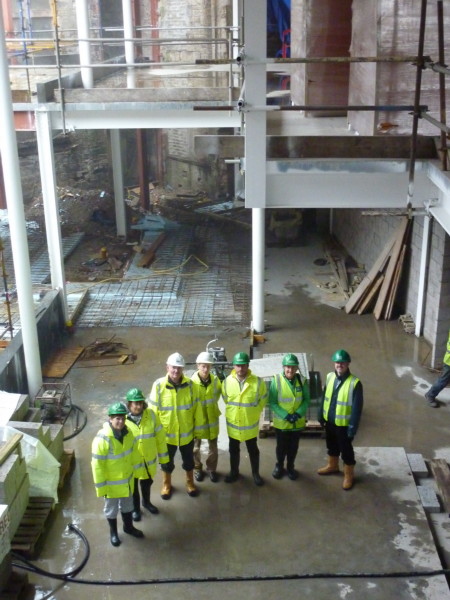
Replica stained glass panel on display in Glasgow Club, Maryhill
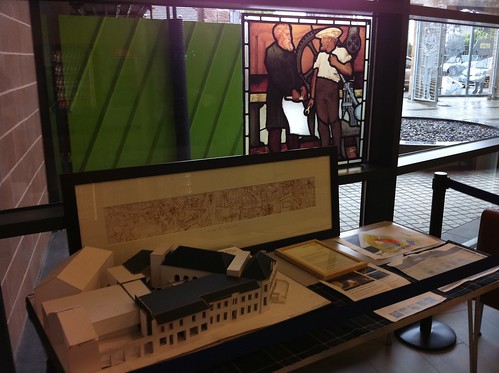
On display in the foyer of the Glasgow Club Maryhill, Gairbraid Avenue.
The panel is the Engineers - The likely source of this panel is the Maryhill Engine Works on Lochburn Road, built in 1873 for the Clarkson Brothers. Possibly one of the brothers is featured here, explaining to the workman with the spanner the details of the next job. The building still exists in Lochburn Road.
The Andy Scott designed Firemen Gates can be seen in the background.
Thanks to Glasgow Museums for the loan of the replica panel.
MINISTER VISITS THE HALLS SAVED FOR MARYHILL
Praise for “cultural gem’ as Alex Neil sees first hand how historic halls are being brought back to life
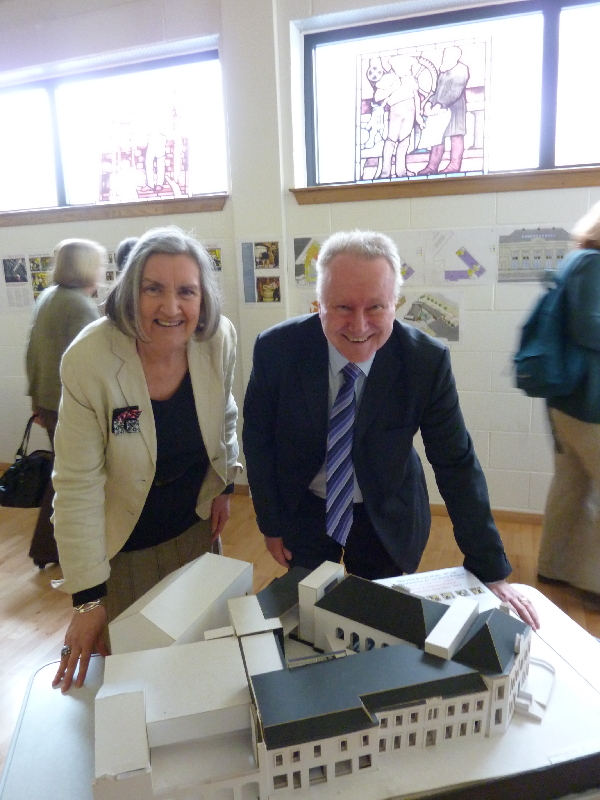
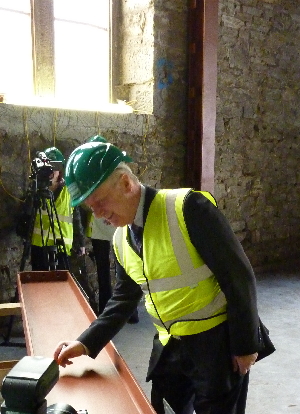
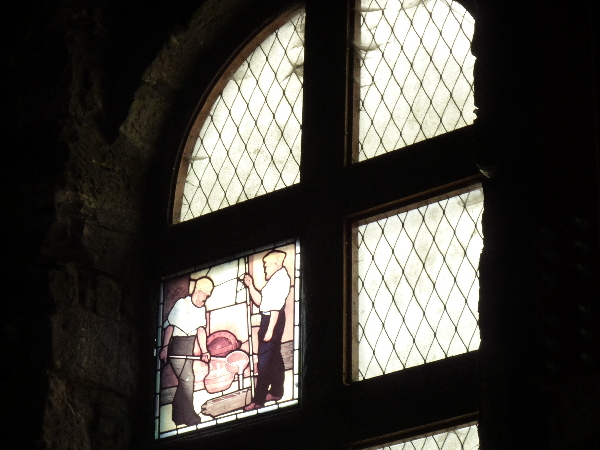
UNVEILED! First glimpse of magnificent gates for Maryhill Burgh Halls


Hats Off As Work Begins On Halls!


Boost for Burgh Halls
Welcome to the Maryhill Burgh Halls Blog
Here you will find in-depth research and snippets into our local history which has been conducted by volunteers, staff and friends of the Halls.




